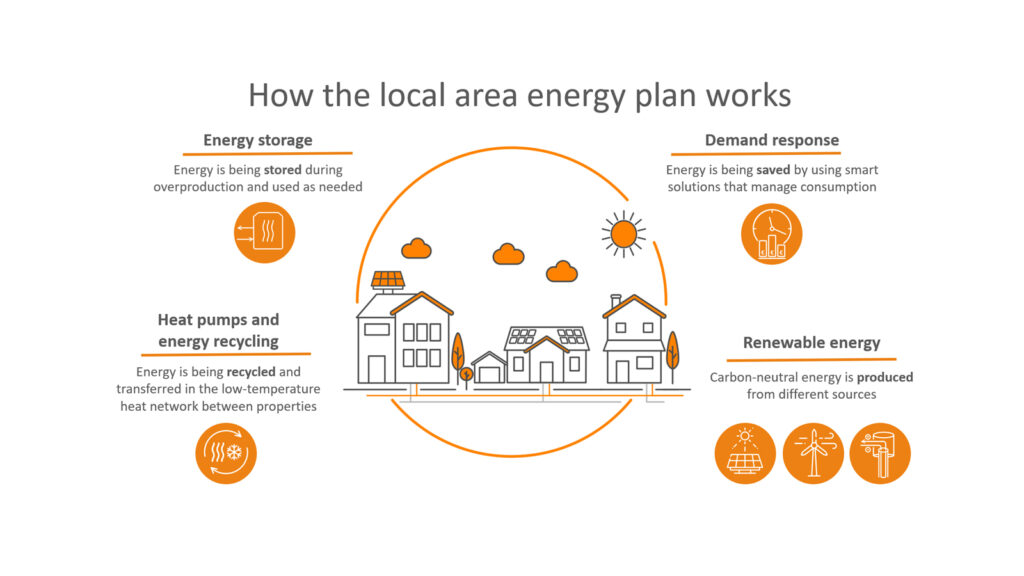Five Insights into the Future Superblock
Local area energy plans support carbon-neutral urban planning. The superblock of the future is built on these principles.
A carbon-neutral local area energy plan is the result of working together towards mutual goals. Utilizing waste energy flows and the opportunities provided by low-temperature heat networks and demand response are key factors in energy and cost-efficient urban planning of the future.
The ongoing NSDC initiative, together with previous projects, has generated many valuable insights. Here are five of them.
1. Solutions emerge through dialogue
A local area energy plan is based on extensive collaboration. It is crucial to engage in dialogue between property developers, energy companies, cities, and planners, to ensure that all solutions benefit the entire energy plan, and not just individual parties. At the core of the development work is systems thinking, where everything affects everything.
Cities want to invest in urban planning in order to achieve their carbon neutrality goals. Affecting the energy consumption of buildings through solutions made by energy companies is one method. The problem is that decarbonizing the entire energy system while the green transition is still ongoing, and fossil fuels are still used in energy production, is difficult.
Property-specific, or joint plans for multiple properties that are based on local and renewable energy, are another solution. Both are needed to achieve the goals.
2. The contract process requires time and commitment
Granlund has been involved in developing several energy plans, where we have engaged in market dialogue, drafted energy partnership agreements, and bid on energy suppliers. We have discovered that the contracting process is complex and requires plenty of time.
Suppliers should be contacted early in the project to ensure all parties have enough flexibility to implement the necessary solutions. For the project to be successful it is important that all parties commit to the project throughout its development, implementation, and maintenance phases.
Granlund offers experience-based expertise when considering, what kind of an implementation is viable. The contracts can last up to twenty years and must benefit all parties.
3. The use of district heating must be timed wisely
A local area energy plan should primarily utilize the internal waste energy flows of the area. These are generated, for example, from the cooling systems and commercial refrigeration equipment. Energy is also produced using boreholes and heat pumps.
Energy storage can cover momentary peaks and increase renewable energy coverage, but it is not cost-effective to size the base production to cover energy consumption fully.
The remaining energy shortfall is typically covered by an electric boiler or district heating. If aiming for carbon neutrality, the use of district heating must be timed wisely when utilizing this type of district heating hybrid solution.
During peak consumption fossil production methods, such as oil and gas, are also used in district heating production. Therefore, district heating should be utilized outside of peak times when energy consumption is low, and only renewable energy production methods are being used.
4. A Low-temperature heat network enables the utilization of waste heat
In a local area energy plan, a low-temperature heat network is used to distribute heat to the buildings in the area. Heat is produced to the network from waste heat sources including ground-source boreholes, air-to-water heat pumps, and electric boilers. The higher the temperature of the water produced by the heat pump, the worse the efficiency. When the temperature is kept low, the efficiency of the heat pump is better, and the heat network’s thermal losses are smaller.
The traditional district heating water temperature is usually between 80–115 degrees Celsius, but in a low-temperature heat network, it is only 40–50 degrees. This low temperature allows the utilization of waste heat generated from, for example, commercial cooling and refrigeration equipment and its distribution through the area’s heat distribution network.
5. Demand response reduces costs
Demand response means adjusting the indoor conditions of a building when energy consumption is at its peak. Savings are achieved by allowing the indoor temperature to momentarily drop to 18 degrees Celsius during extreme cold, or by reducing consumption in other ways when electricity prices are at their highest.
A so-called rebound effect refers to a higher consumption after the response period, allowing the return to a normal indoor temperature. Savings are achieved by shifting consumption from expensive periods to cheaper ones. In a local area energy plan demand response is automated using system connections and algorithms.

A local area energy plan refers to the entirety formed by the buildings, different energy production methods, energy networks, energy storage in the area, and their interactions.
Local area energy plan is at the core of urban planning
- A local area energy plan refers to the entirety formed by the buildings, different energy production methods, energy networks, energy storage in the area, and their interactions. The goal is to promote carbon neutrality and reduce energy costs.
- The area’s energy supply is based on local renewable energy sources. The system utilizes internal waste energy flows. Energy consumption adjusts to consumption peaks.
- Granlund is involved in Business Finland’s two-and-a-half-year NSDC initiative, which develops a local area energy plan to support energy and cost-efficient urban planning. NSDC stands for The Nordic Superblocks as Decarbonization Catalysts. A superblock can be, for example, an area formed by several blocks, or a district.
Want to discuss more about local area energy plans?
To learn more about how local area energy plans help make urban planning carbon neutral, reach out to Project Manager
Oskari Fagerström, Granlund Group at +358 50 382 3813, firstname.lastname@granlund.fi
Read more:
Development of sustainable solutions expands from real estate to city blocks
